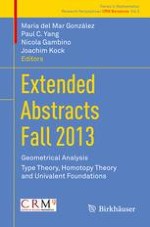The two parts of the present volume contain extended conference abstracts corresponding to selected talks given by participants at the "Conference on Geometric Analysis" (thirteen abstracts) and at the "Conference on Type Theory, Homotopy Theory and Univalent Foundations" (seven abstracts), both held at the Centre de Recerca Matemàtica (CRM) in Barcelona from July 1st to 5th, 2013, and from September 23th to 27th, 2013, respectively. Most of them are brief articles, containing preliminary presentations of new results not yet published in regular research journals. The articles are the result of a direct collaboration between active researchers in the area after working in a dynamic and productive atmosphere.
The first part is about Geometric Analysis and Conformal Geometry; this modern field lies at the intersection of many branches of mathematics (Riemannian, Conformal, Complex or Algebraic Geometry, Calculus of Variations, PDE's, etc) and relates directly to the physical world, since many natural phenomena posses an intrinsic geometric content. The second part is about Type Theory, Homotopy Theory and Univalent Foundations.
The book is intended for established researchers, as well as for PhD and postdoctoral students who want to learn more about the latest advances in these highly active areas of research.
